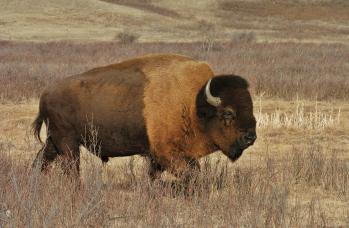
The American Bison (Bos bison) is the only wild member of the cattle family (Bovidae) in Saskatchewan. The family of approximately 125 species occurs in the Northern Hemisphere, Africa, and Asia; five species are found in North America. The family contains ruminant animals with cloven hooves, permanent horns over bony lateral processes on the skull, and no upper incisors or canines. Adult male American Bison are the largest land animals in North America; at nearly 1,000 kg in weight, they are larger than grizzly or polar bears. The females are considerably smaller, at about 600 kg. The body shape of heavy forequarters and smaller hindquarters give a distinctive outline and a rocking gait when galloping. The heavy forequarters are due to the large flat-faced skull and the long spines on the thoracic vertebrae which support the large muscles that move the skull. The heavy mane of wooly dark-brown fur over the shoulders and head, along with the beard, emphasizes the heaviness of the head and chest. The coat on the rest of the body is shorter and lighter brown. The coat of the single calf, born in the spring, is light brown.
Bison are gregarious, staying in small family groups that may join others to form larger herds. Before European settlement, bison were found throughout North America from the East Coast to the Rocky Mountains—in small groups in the woodlands and in large migratory herds on the prairie grasslands. Bison were the dominant animal in the grasslands ecosystem, cropping the grasses, breaking the soil with their hooves, and dunging as they moved over the landscape; they also fed on flowering plants, including young trees and shrubs, preventing their growth and replacement of the grasses.
With European settlement, the bison were killed for food and sport, for their hides, to prevent their interbreeding with imported domestic cattle, and to remove them as competitors for pasture for domestic livestock. In the United States, in particular, they were slaughtered to remove them from possible use by the local First Nations, who were dependent on them for food and other uses. By the end of the 19th century, the species was almost eliminated; only deliberate and continuing conservation efforts have maintained its survival. Even so, the species is found only in controlled environments such as parks or private herds; there are no free-ranging animals. The closest relative of the American Bison, the European bison (B. bonasus), has approximately the same history and is now found only in park herds in eastern Europe.
Diane Secoy